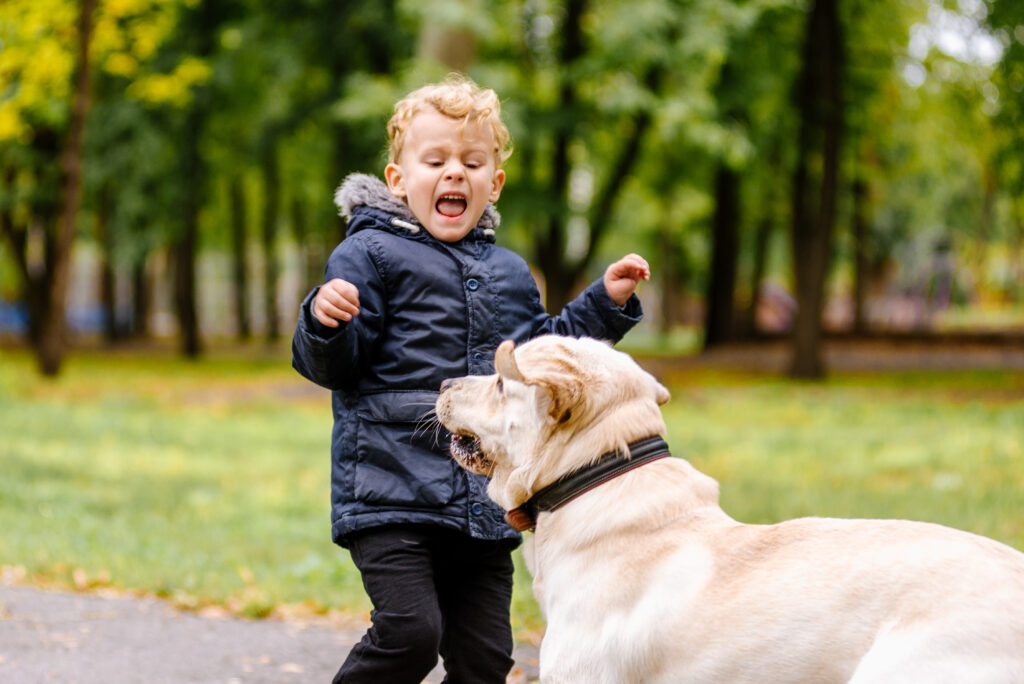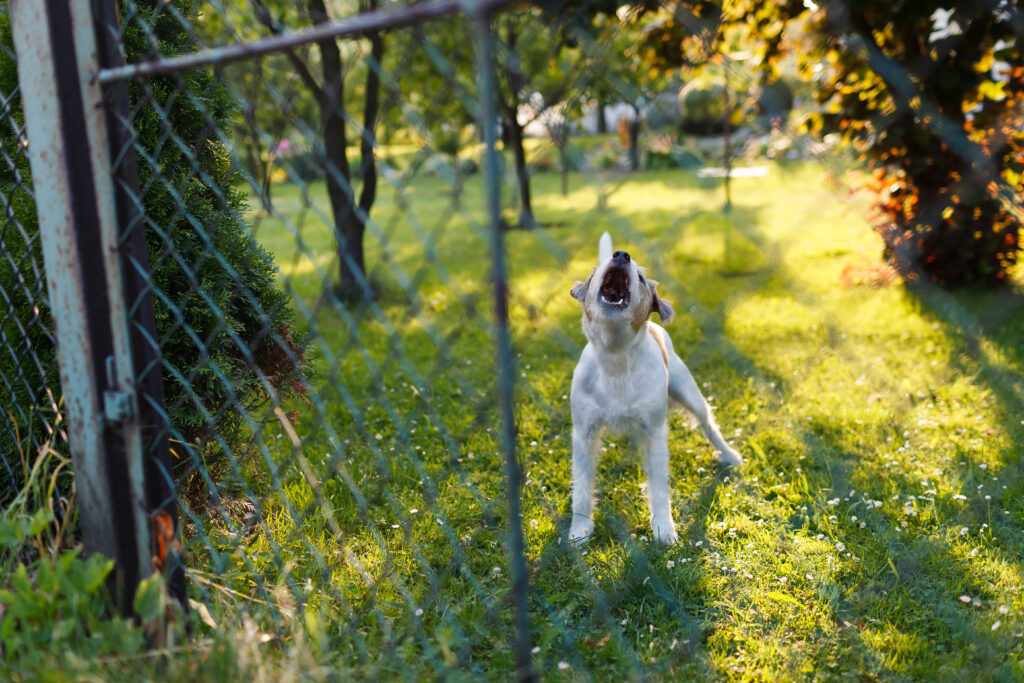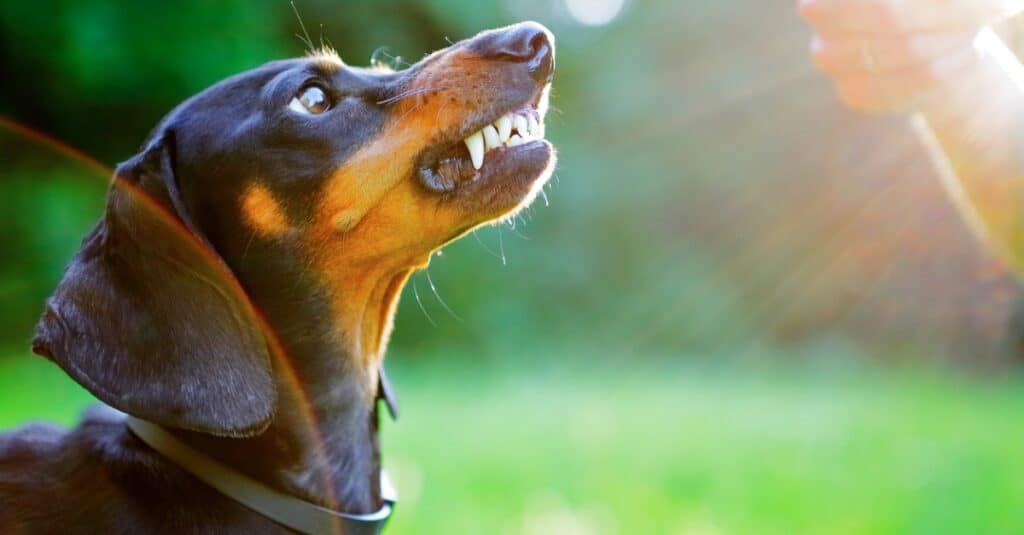It can be hard when your dog only bites one person in the house. You get to see how sweet they are with everyone else, yet they’re mean to one individual! Sometimes, it can even be hard to know why this is happening.
Dogs typically bite just one person in the household because they have a bad past experience, aren’t well-socialized, or the person doesn’t know how to interact properly with dogs. It could also be resource-guarding behavior.
In this article, we’ll talk about why there’s only one person your dog bites in the house and a few ways to prevent it from happening in the future.
They’ve Been Traumatized by Someone Similar

Well-socialized dogs have fewer fears and tend to be more confident.
©Helen Sushitskaya/Shutterstock.com
Your dog may have been hurt or scared by someone similar to the person they’re biting in the household. This could mean another man, someone who wore a baseball hat, or someone who looked or acted similarly.
If you don’t know your dog’s past, it can be difficult to predict how they will react to things now and in the future. They might have unexplained behaviors, like biting, that would actually make perfect sense if you knew what they’d been through.
The Dog is Afraid of Men
Even without trauma, some dogs fear men. This is especially true if they weren’t well-socialized early in life and weren’t really around men.
Though it’s obviously not always true, men are often larger and louder than women and have deeper voices. All of these things can be scary for a dog!
I’ve found that some of my pets have been afraid of large men, while they don’t mind shorter, soft-spoken men as much. I’ve also noticed that my pets, who grew up around men, aren’t afraid of men at all. I guess it’s because having men around showed them they aren’t a threat.
The Dog Lacks Socialization
Puppies should be in contact with various people, places, and things. Well-socialized dogs have fewer fears and tend to be more confident.
Dogs who don’t receive socialization might fear certain types of people. This might mean people of certain ethnicities or gender wearing certain clothing or using mobility aids like canes or wheelchairs.
Things that don’t seem like a big deal to humans can be super scary to dogs if they’ve never seen or experienced them before!
A Person’s Personality or Mental Illness
Some studies show that people who are mentally unstable or are neurotic get bit by dogs more frequently.
There’s no real telling why this is. Perhaps the person’s unease makes the dog feel uneasy, or the person is less predictable and, therefore, scary.
Children Who Don’t Know How to Interact with Dogs
Dogs bite children more often than adults, most commonly due to children not knowing how to interact with dogs.
It’s not your dog’s job to put up with a child hanging on them, messing with their food, or even hurting them. It’s on the adults in the household to supervise interactions between dogs and kids and teach them how to interact properly.
Never allow children to hurt or roughhouse with a dog. Keep children away from your dog’s food. In addition, ensure your dog has a space to go where kids can’t reach. This could be a room in the house, crate, or bed.
Teach kids about dog body language. Lastly, teach them to be gentle and calm around animals.
When your kids are running about and yelling, take the dog to a separate space. This is normal behavior for kids but can be very stressful for some dogs.
The Person Disrespects Your Dog’s Boundaries

Dogs bite children more often than adults, most commonly due to children not knowing how to interact with dogs.
©Canon Boy/Shutterstock.com
If someone in the household refuses to accept your dog’s boundaries, that would explain them getting bit! Everyone else likely manages not to because they listen to your dog’s cues.
Some people believe you should be able to mess with a dog all you want, and they shouldn’t retaliate. This is unfair and an expectation many dogs cannot and will not meet.
Everyone in your home should be taught to read dog body language so that they notice when your dog is saying “no.” They should also be taught to respect that no, and to ask for consent when interacting with the dog.
For instance, instead of running up to pet them, sit down and ask if they want to come over by holding your hand or teaching them a cue. (Mine is simple, “want to be petted?”)
They Allow Biting During Play
Another big mistake is allowing biting during play and expecting your dog to know not to bite you the rest of the time.
They might be biting the person who does this to get them to play, or they might even bite outside of play because they’ve been taught biting, in general, is okay.
Never allow your dog to bite any part of your body in play–if they do, walk away and end play for at least a few minutes each time. The longer they’ve been allowed to bite, the longer it’ll take for them to learn it isn’t okay. But with repetition, they will learn.
You can also redirect biting to acceptable items, like toys.
They’re Using Harsh Training Techniques
Harsh training techniques have been proven to promote fearfulness and aggression. I recommend avoiding all aversive training techniques for all dogs, especially those already showing aggression.
The worst training method is the dominance theory of dog training. This states that you must be the “alpha dog” and lead the pack. Often, the methods are borderline abusive at best–and extremely abusive at worst.
This theory comes from observing captive wolf packs, but it’s since been shown that wolves naturally live in family structures. The parents are in charge, just like in most human families. There is not a lot of fighting, and certainly, no “alpha” who uses aggression to control the others.
The Person is Abusive

Harsh training techniques have been proven to promote fearfulness and aggression.
©Fercast/Shutterstock.com
If the person is physically or verbally abusive to anyone in the household, your dog might bite them. They might be protecting themselves or other people or pets in the home.
There’s Been a Recent Change
Dogs like routine and often dislike big, sudden changes in their lives, like moving house, having a new family member, or even just having to go on their daily walk at night instead of in the morning.
If there’s been a recent lifestyle change and your dog associates it with a certain person, this might be why they’re biting them and no one else.
For instance, if you’ve moved into your partner’s home and your dog now has a new routine, a new home, and gets less of your time, they might be blaming it on them!
Your Dog is Guarding Someone or Something
Lastly, your dog might be guarding someone or something. This could be a person, other pet, toy, food–anything they find valuable.
Guarding is sometimes good–it’s why we’ve bred guarding breeds to protect our households for thousands of years. But, guarding can go bad when the dog takes it too far, seeing threats where there are none.
It’s also bad when your dog is resource-guarding things like attention, food, toys, etc. Your dog feels insecure, and of course, the bigger issue is someone gets bit who likely isn’t doing anything wrong.
Preventing Dog Bites

Biting should be taken seriously; it typically requires a professional to help and keep everyone safe.
©Paya Mona/Shutterstock.com
See a Trainer or Certified Veterinary Behaviorist
Biting should be taken seriously; it typically requires a professional to help and keep everyone safe.
Look into your trainer or behaviorist carefully. Anyone can call themselves a dog trainer or dog behaviorist. It’s an unregulated market, and even some good trainers aren’t able to handle aggression cases.
A certified veterinary behaviorist has been trained and is certified, making them more reliable. Otherwise, look for someone who uses force-free techniques, avoids aversives, and has experience training aggressive dogs.
Avoid anyone who talks about being the alpha or dominating your dog. Also, avoid so-called “balanced” trainers, which means they’re willing to use aversives and hurt your dog to get compliance.
These methods are not only inhumane but also work less effectively. Sometimes you’ll see quick results if a dog shuts down, and neither you nor the trainer knows enough to see that this is happening. You’ll then see your dog revert to their old behavior, or sometimes bite even harder.
This happens because you didn’t get to the root of the problem; you just got your dog to the point where they were afraid to show any emotion or reaction. Just like humans, if a dog stuffs all their feelings down, it will eventually have to release all that pent-up anger, hurt, or fear.
Avoid Aversive Training Methods
We addressed this above, but I’ll go into more detail here about what aversive training methods look like and what to use instead.
There are four quadrants of dog training:
- Positive reinforcement: Adding something to get a desired behavior
- Positive punishment: Adding something to prevent an undesired behavior
- Negative reinforcement: Taking something away to get a desired behavior
- Negative punishment: Taking something away to prevent an undesired behavior
We want to use positive reinforcement and negative punishment while avoiding positive punishment and negative reinforcement whenever possible.
Examples of positive reinforcement include giving your dog treats for doing tricks or rewarding them with play when they come when called.
Negative punishment is walking away when a dog bites during play, so they know they won’t get attention when they bite.
Examples
Positive punishment is adding something your dog dislikes to stop their behavior. This includes hitting, yelling, spraying them with water, or using a shock collar for misbehavior. These things erode your dog’s trust in you, damage your relationship, and are often even abusive.
Negative reinforcement is when you take something away that your dog dislikes to get them to do something. This could be pushing on their butt until they sit because they don’t like the pressure. Or, shocking your dog with a collar until they do as you say, then stopping as a “reward.”
These things also harm your dog and your relationship with them. There are also simply better ways, even for things that seem innocuous, like pushing on your dog’s rear.
This method can hurt them and definitely makes them uncomfortable–because if it didn’t, it wouldn’t work.
But guiding them into place with a treat and rewarding them with it brings us the same result, without that discomfort or risk of injury. That’s why it’s a better method to employ.
Use Management Techniques
Management, in this case, likely means keeping your dog away from the person they’re biting, either temporarily or permanently.
For instance, you might need to keep the kids away from your dog at mealtime if it tends to bite when they approach the dish. This might mean closing a door or needing to make even more changes for some households.
You might need to move your dog’s bowl to a room you can keep the kids out of or switch your dog from free-feeding to scheduled meal times throughout the day.
Management can also look like avoiding your dog’s triggers around the person they bite. An example of this would be picking up their toys when a certain person visits so your dog can’t resource guard or get too hyper around them.
Or, maybe you need to teach people not to run around your dog until you can teach them not to chase and bite people who are running.
“Train” the Person
Sometimes it’s the person who needs training, not the dog. This is even more likely when your dog only bites a specific person in the household–it’s likely they’re doing something wrong, or at least something no one else is doing.
This person might need to learn:
- How to interact gently and calmly
- How to read dog body language and respect boundaries
- Not to allow a dog to bite during play
Sometimes dogs have triggers that make less sense and aren’t reasonable to accommodate. But chances are, you’ll still need to have the person stop doing it or keep the dog separate until it is trained or desensitized.
For instance, it’s normal for kids to shout and run around–but if your dog cannot handle that behavior now, you’ll need to teach the kids to be quiet around the dog. When they need to get all that energy out, take the dog for a walk or put them in their crate in a quieter area of the house.
Desensitization and Counterconditioning

Just like humans, if a dog stuffs all their feelings down, it will eventually have to release all that pent-up anger, hurt, or fear.
©Christian Mueller/Shutterstock.com
Desensitization and counterconditioning are ways to reduce fear in dogs. Your dog is exposed to the person they bite in ways that feel safe to them and taught (or counter-conditioned) to think of them in a more positive light.
This might look like going outside and having the person stand far away while someone else keeps the dog on a leash. The person holding the leash should let the dog look around, observe the person they fear, and reward them when they choose not to engage by barking, lunging, or showing aggressive behavior.
Practice this over a long period of time while going at the dog’s pace until they can be standing right next to the person without fear or biting. You might then progress to the feared person handing the dog treats and praising them gently to associate them with that reward further.
This method can be done independently but is better handled by an experienced trainer or behaviorist. This is especially true if you have a large dog or one who bites hard. Trying to handle these cases yourself can put people in harm’s way and put your dog at risk.
Rehoming
In some cases, rehoming might be the best option to keep everyone safe. If the person won’t change their behavior, or your dog is too dangerous for the person to be around, it might be time to look for a suitable new home.
This is the most successful when it’s truly the person’s fault or when something specific about them triggers the dog.
For instance, your dog might require a home without men or children. Or, they might do better in a home where there isn’t a person picking on them or being abusive.
Luckily, when a dog is only biting one person, you can pinpoint why, and it’s often easier to find them a home where the family adopting it will be safe. After all, you never want to pass on aggression problems to someone else or put them at risk.
Always disclose your dog’s history to the new adopters!
How Do You Tell if a Dog is About to Bite?

If a dog bares its teeth at you, even if the tail is wagging, back away.
©iStock.com/alexandrshevchenko
The most important factor in determining if a dog is about to bite is body language. Dogs communicate through body language and physical signs, and it’s up to you to read them correctly. Here are some of the tell-tale signs that a dog might be getting ready to bite:
- The ears may be back or flattened against the head.
- The eyes may be squinted or wide open.
- The tail may be tucked between the legs.
- The dog may growl, snarl, or bark.
- The lips may be curled back in a snarl.
- The hackles (hair along the neck and spine) may rise.
- The body posture may become stiff and rigid as if ready to pounce.
If you see any of these signs, it’s important to move away from the dog slowly and calmly without making eye contact or sudden movements. Do not try to pet or touch the dog at this time.
The photo featured at the top of this post is © Helen Sushitskaya/Shutterstock.com
Ready to discover the top 10 cutest dog breeds in the entire world?
How about the fastest dogs, the largest dogs and those that are -- quite frankly -- just the kindest dogs on the planet? Each day, AZ Animals sends out lists just like this to our thousands of email subscribers. And the best part? It's FREE. Join today by entering your email below.
Thank you for reading! Have some feedback for us? Contact the AZ Animals editorial team.






